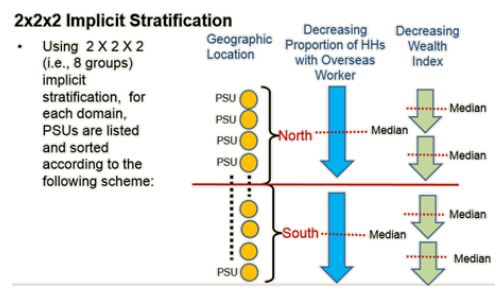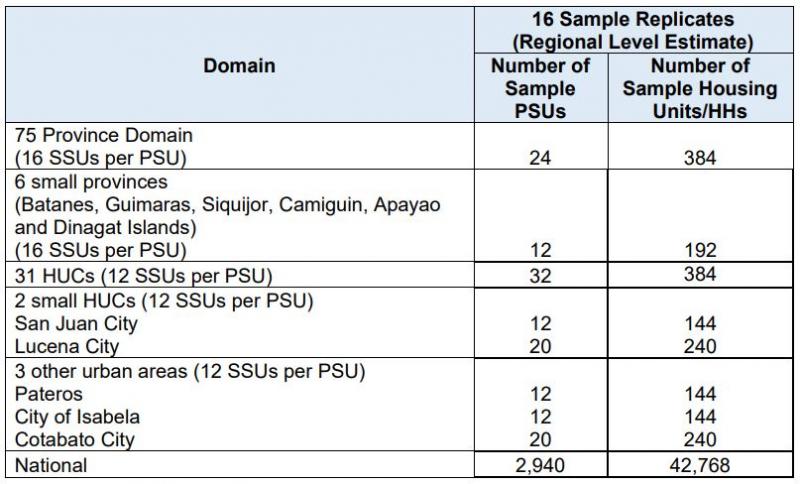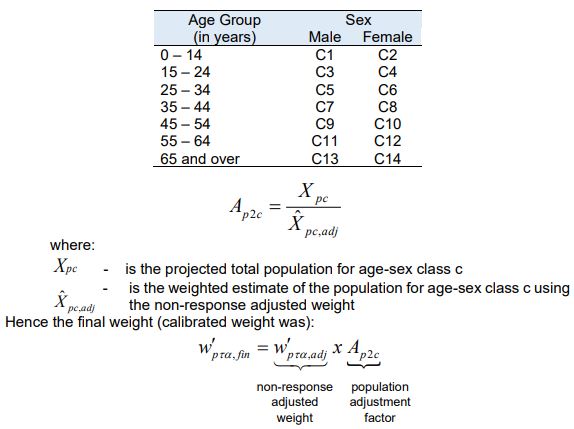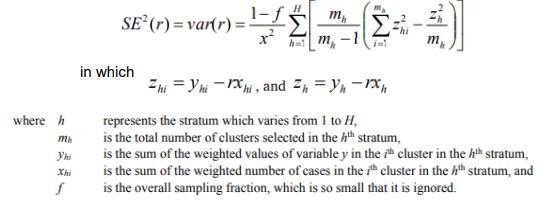About SOF
I. Introduction
-
Background
The Survey on Overseas Filipinos (SOF) is a nationwide survey designed to gather information on Filipino citizens abroad, including overseas workers, who left the country for employment during the five years preceding the survey, that is, from October 2014 to September 2019. Data on their remittances, for example, were gathered using the past six months as reference period. The SOF is conducted every year as a rider survey to the October round of the Labor Force Survey (LFS).
The data collection of the characteristics of overseas workers started in 1982 using a one- page rider questionnaire in the Integrated Survey of Households (ISH) and continued until 1986.
In 1987, during the revision of the LFS questionnaire (ISH Form 2), a column indicator for Overseas Contract Workers (OCWs) was added to get the estimate of the number of OCWs. With the increasing demand for information on overseas workers, the Survey on Overseas Workers (SOW) was resumed in 1991. The previous questionnaire was revised to generate more comprehensive data.
Data on international migration were gathered in the 1988 National Demographic Survey (NDS). With the expanded coverage of the 1993 NDS on health and immunization, the section
on international migration was deleted from the NDS, but it was recommended for inclusion in SOW starting 1992. In 1993, the SOW was renamed to SOF.
-
OBJECTIVES OF THE SURVEY
The SOF aims to provide data on overseas Filipinos particularly the overseas contract workers and their contribution to the economy. Specifically, the survey has the following objectives:
-
to obtain national estimates on the number of overseas Filipinos including overseas workers and their socio-economic characteristics; and
-
to provide estimates on the amount of cash and in-kind transfers received by the families and the modes of remittances.
-
Scope and Coverage
With regions as domain, survey operations for 2020 SOF ran from 08 to 31 October 2020, and covered 44,257 eligible sample households, of these 3,709 households have Overseas Filipino Workers.
-
Limitations of the Survey
The SOF has the following limitations:
-
Ideally, information about overseas Filipinos should be obtained directly from them. However, since this is not always possible, the information has to come from their relatives or any member of the household who knows the person who left for abroad. The OFWs included in this report are those whose families still reside in the country as of the time of survey visit.
-
The OFWs covered in this report were those working abroad during the period 01 April to 30 September 2020. The workers, who were at home on vacation from their jobs abroad who left earlier than April 1 of the reference year, were also included in this report as long as they worked during the specified reference period.
-
The SOF did not ask for the total salary received by the OFWs. Hence, the remittances presented in the results may just be a part of the total salary received by the OFWs.
-
Starting April 2016 round of the Labor Force Survey (LFS), the 2013 Master Sample (MS) design has been adopted. The number of sample household is around 45,000. The SOF, being a rider to the LFS, has adopted the 2013 MS starting October 2016. Careful evaluation must be made in comparing the results of the 2019 SOF with other SOF results prior to the implementation of the 2013 MS.
-
The 2012 Philippine Standard Occupational Standard (PSOC) was adopted starting October 2016. The 1992 PSOC had been used prior to October 2016.
II. Concepts and Definitions
-
Overseas Filipinos
For purposes of this survey, the following are considered as overseas Filipinos as long as their departure occurred within the given five-year period:
-
Filipino OCWs who are presently and temporarily out of the country to fulfill an overseas work contract for a specific length of time, or who are presently at home on vacation but still has an existing contract to work abroad. They may either be land-based or sea-based.
a. Land-based workers – these are OCWs who are hired either by direct hiring of an employer abroad, or through the assistance of Philippine Overseas Employment Administration (POEA), or through a private and licensed recruitment agency. They may have returned to the Philippines for a vacation (annual or emergency leave), or have transferred to other employers, or were rehired by their former employer.
b. Sea-based workers – these are OCWs who worked or are working in any kind of international fishing/passenger/cargo vessels. Included also are OCWs who worked or are working for a shipping company abroad.
-
Other Filipino workers abroad with a valid working visa or work permit. Included also are crew members of airplanes such as pilots, stewards, stewardesses and others whose employers are foreign nationals.
-
Filipino workers other than those who work on contractual basis. These include Filipinos who went out of the country through backdoor means and worked there during the reference period.
-
Filipinos whose place of employment is outside the Philippines but whose employer is the Philippine government.
-
Filipinos who are sent abroad by the Philippine government or by private institutions for training, scholarship, or any other similar purpose, even if they are known to be working abroad.
-
Filipinos working in other countries who are hired as consultants/ advisors of international organizations such as the United Nations, International Monetary Fund, and others.
-
Filipino immigrants and residents in other countries.
-
Filipinos abroad who are holders of other types of non-immigrant visa such as visa for tourist/visitor, student, medical treatment, and others.
-
Overseas Filipino Workers
OFWs include OCWs who were presently and temporarily out of the country during the reference period to fulfill an overseas contract for a specific length of time, or who were presently at home on vacation during the reference period but still had an existing contract to work abroad. Also included were other Filipino workers abroad with valid working visas or work permits. Those who had no working visa or work permit (tourists, visitors, students, those seeking medical treatment, and other types of non-immigrants) but were presently employed and working full time in other countries were also classified as OFWs.
III. Sampling Design and Estimation Methodology
Starting with the October 2016 round, the SOF, as a rider survey to the LFS, used the sampling design of the 2013 MS for household-based surveys. The 2013 MS was used starting April 2016. This section describes the sampling domains in the 2013 MS, the primary sampling units used, the 2x2x2 implicit stratification and sample allocation scheme, and the sample size used for the October 2020 round of the LFS and SOF.
Sampling Frame
The 2013 MS sampling frame was constructed using the 2010 Census of Population and Housing but was refreshed with the results of the 2015 Population Census. The EA Reference File (EARF) of the 2015 Census of Population was used as the Primary Sampling Unit (PSU) frame while the 2015 list of households for each of the PSUs were used as the Secondary Sampling Unit (SSU) frame.
Sampling Domain
To provide subnational or provincial level statistics with precise estimates, the 2013 MS has 117 major domains as follows: 81 provinces (including the newly created province Davao Occidental); 33 highly urbanized cities (including 16 cities in the National Capital Region); and 3 other areas (Pateros, Isabela City, and Cotabato City).
Primary Sampling Units
In the 2013 Master Sample Design, each sampling domain (i.e., province/HUC) is divided into exhaustive and non-overlapping area segments known as Primary Sampling Units (PSUs) with about 100 to 400 households. Thus, a PSU can be a barangay/Enumeration Area (EA) or a portion of a large barangay, or two or more adjacent small barangays/EAs.
2x2x2 Implicit Stratification

The PSUs are then ordered according to the following: (1) North-South/West-East Geographic location; (2) Decreasing Proportion of HHs with Overseas Worker; and (3) Decreasing wealth Index.
Replicates
There are 117 sampling domains. Replicated sampling is used. A replicate is composed of ordered list of PSUs. Most of the provinces, that is, 75 out of 81, has six PSUs per replicate while in HUCs, eight PSUs form a replicate. Small domains, namely, Batanes, Guimaras, Siquijor, Camiguin, Apayao, and Dinagat Islands had three PSUs per replicate.
Sample Allocation Scheme
A total of 4 sample replicates were allotted for the October 2021 round. The total number of sample SSUs was allotted proportionately to the measure of size of the PSU. Thus, a PSU with only 100 HHs had less number of sample HHs than PSUs with 400 HHs. On average, there were 12 sample HHs allotted for each PSU in Highly Urbanized Cities (HUCs) and an average of 16 sample HHs for every PSU in the province A total national sample of 42,768 sample HHs was allotted for the October 2021 round of the LFS and SOF.

Base weight computation
The base weight is computed as the inverse of selection probability

For housing units with at most 3 households the base weight is computed as

For housing units with more than 3 households the base weight is computed as

Base Weight Adjustment
The base weight was adjusted for unit non-response and was further calibrated to conform to the known or projected population count. The projected population count used was July 2021.
For unit non-response adjustment (within domain p), the adjustment was computed as:

Applying this to the base weight, we have:
![]()
Further calibration was made to conform with known population count, as follows:

Estimation of Totals
-
Generally, the estimate for the weighted total for a sampling domain
(province/HUC) considering the number of sample replicates was derived using:

-
For each of the sampling domain which considered 16 sample, the estimate for the weighted total was computed as the value of the sample household for variable Y multiplied by its corresponding weight using this formula:
![]()
-
For the Province/HUC
The estimate for the weighted total for the province/HUC was derived as the average of the estimates for the 16 replicates

-
For the region
The estimate for the weighted total for the region was derived as the sum of its weighted provinces/HUCs domain totals:

Estimation of Rates and Proportions
Rates will be computed as for example employment rate:
![]()
Where
![]()
To estimate the weighted proportion p̂r in the rth region

Estimation of Sampling Error
Sampling error is usually measured in terms of the standard error for a particular statistic (mean, percentage, etc.), which is the square root of the variance.
If the sample had been selected as a simple random sample, it would have been possible to use straightforward formulas for calculating sampling errors. However, the LFS is the result of a multi-stage design, and it was necessary to use more complex formulas.
Sampling errors are computed using statistical programs. These statistical programs use the Taylor linearization method to estimate variances for survey estimates that are means, proportions, or ratios.
The Taylor linearization method treats any percentage or average as a ratio estimate, r=y/x, where y represents the total sample value for variable y, and x represents the total number of cases in the group or subgroup under consideration. The variance of r is computed using the formula given below, with the standard error being the square root of the variance:

In the SOF, the 117 province/HUC domains are also treated as natural stratification while the PSUs are treated as clusters.
Data Checking, Coding and Filtering Prior to Estimation of Proportions
Enumeration was a very complex operation, and it may happen that reported/encoded entries during data collection may have some omissions and implausible or inconsistent entries. Editing was meant to correct these errors.
During the interview, embedded editing was activated, and errors/inconsistent entries were detected by the program. Editing was also done using Computer Aided Field Editing (CAFE) program after every interviewed household to ensure completeness and consistency of encoded entries. For monitoring of the status of data collection, SOF raw data from the tablet is uploaded to the PSA Central Office server as soon as the interview of a household/EA was completed.
The SOF raw data from the tablet is uploaded to the PSA Central Office server as soon as the interview of a household/EA was completed.
Review and verification of the PSOC and PSIC codes and invalid values for SOF data items were done in the provincial office using the SOF Information System (SOF IS).
Further processing in the regional office such as ID validation and completeness check, edit and matching of SOF sample households with the original List from Master Sample Form 6 were done to ensure that the number of household listed was fully covered.
Preliminary and final tabulations of data were done at the Central Office.

